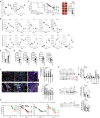PTX3 Regulation of Inflammation, Hemostatic Response, Tissue Repair, and Resolution of Fibrosis Favors a Role in Limiting Idiopathic Pulmonary Fibrosis
- PMID: 34276664
- PMCID: PMC8284251
- DOI: 10.3389/fimmu.2021.676702
PTX3 Regulation of Inflammation, Hemostatic Response, Tissue Repair, and Resolution of Fibrosis Favors a Role in Limiting Idiopathic Pulmonary Fibrosis
Abstract
PTX3 is a soluble pattern recognition molecule (PRM) belonging to the humoral innate immune system, rapidly produced at inflammatory sites by phagocytes and stromal cells in response to infection or tissue injury. PTX3 interacts with microbial moieties and selected pathogens, with molecules of the complement and hemostatic systems, and with extracellular matrix (ECM) components. In wound sites, PTX3 interacts with fibrin and plasminogen and favors a timely removal of fibrin-rich ECM for an efficient tissue repair. Idiopathic Pulmonary Fibrosis (IPF) is a chronic and progressive interstitial lung disease of unknown origin, associated with excessive ECM deposition affecting tissue architecture, with irreversible loss of lung function and impact on the patient's life quality. Maccarinelli et al. recently demonstrated a protective role of PTX3 using the bleomycin (BLM)-induced experimental model of lung fibrosis, in line with the reported role of PTX3 in tissue repair. However, the mechanisms and therapeutic potential of PTX3 in IPF remained to be investigated. Herein, we provide new insights on the possible role of PTX3 in the development of IPF and BLM-induced lung fibrosis. In mice, PTX3-deficiency was associated with worsening of the disease and with impaired fibrin removal and subsequently increased collagen deposition. In IPF patients, microarray data indicated a down-regulation of PTX3 expression, thus suggesting a potential rational underlying the development of disease. Therefore, we provide new insights for considering PTX3 as a possible target molecule underlying therapeutic intervention in IPF.
Keywords: IPF; PTX3; fibrosis; hemostasis; humoral immunity; inflammation; resolution.
Copyright © 2021 Doni, Mantovani, Bottazzi and Russo.
Conflict of interest statement
AM and BB are inventors of patents on pentraxin-3 and obtain royalties on related reagents. The remaining authors declare that the research was conducted in the absence of any commercial or financial relationships that could be construed as a potential conflict of interest.
Figures


Similar articles
-
An acidic microenvironment sets the humoral pattern recognition molecule PTX3 in a tissue repair mode.J Exp Med. 2015 Jun 1;212(6):905-25. doi: 10.1084/jem.20141268. Epub 2015 May 11. J Exp Med. 2015. PMID: 25964372 Free PMC article.
-
Humoral innate immunity at the crossroad between microbe and matrix recognition: The role of PTX3 in tissue damage.Semin Cell Dev Biol. 2017 Jan;61:31-40. doi: 10.1016/j.semcdb.2016.07.026. Epub 2016 Jul 29. Semin Cell Dev Biol. 2017. PMID: 27476448 Free PMC article. Review.
-
The Long Pentraxin PTX3 as a Link Between Innate Immunity, Tissue Remodeling, and Cancer.Front Immunol. 2019 Apr 4;10:712. doi: 10.3389/fimmu.2019.00712. eCollection 2019. Front Immunol. 2019. PMID: 31019517 Free PMC article. Review.
-
PTX3, a Humoral Pattern Recognition Molecule, in Innate Immunity, Tissue Repair, and Cancer.Physiol Rev. 2018 Apr 1;98(2):623-639. doi: 10.1152/physrev.00016.2017. Physiol Rev. 2018. PMID: 29412047 Free PMC article.
-
Innate immunity, hemostasis and matrix remodeling: PTX3 as a link.Semin Immunol. 2016 Dec;28(6):570-577. doi: 10.1016/j.smim.2016.10.012. Epub 2016 Nov 20. Semin Immunol. 2016. PMID: 27881292 Free PMC article. Review.
Cited by
-
Serum Pentraxin 3 as Promising Biomarker for the Long-Lasting Inflammatory Response of COVID-19.Int J Mol Sci. 2023 Sep 17;24(18):14195. doi: 10.3390/ijms241814195. Int J Mol Sci. 2023. PMID: 37762499 Free PMC article.
-
Insights into the Relationship between Pentraxin-3 and Cancer.Int J Mol Sci. 2022 Dec 4;23(23):15302. doi: 10.3390/ijms232315302. Int J Mol Sci. 2022. PMID: 36499628 Free PMC article. Review.
-
Pleiotropic antifibrotic actions of aspirin-triggered resolvin D1 in the lungs.Front Immunol. 2023 Mar 7;14:886601. doi: 10.3389/fimmu.2023.886601. eCollection 2023. Front Immunol. 2023. PMID: 36960058 Free PMC article.
-
Interleukin (IL)-33 immunobiology in asthma and airway inflammatory diseases.J Asthma. 2022 Dec;59(12):2530-2538. doi: 10.1080/02770903.2021.2020815. Epub 2021 Dec 27. J Asthma. 2022. PMID: 34928757 Free PMC article.
-
Exploring the preventive effects of Jie Geng Tang on pulmonary fibrosis induced in vitro and in vivo: a network pharmacology approach.Naunyn Schmiedebergs Arch Pharmacol. 2024 Dec;397(12):10005-10016. doi: 10.1007/s00210-024-03262-w. Epub 2024 Jul 3. Naunyn Schmiedebergs Arch Pharmacol. 2024. PMID: 38961002
References
Publication types
MeSH terms
Substances
LinkOut - more resources
Full Text Sources
Miscellaneous

